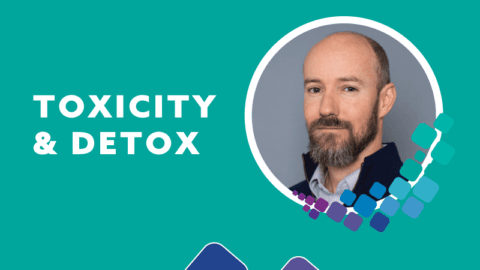Mosaic EDGE (formerly GPL Academy) has been educating practitioners for over 15 years on how to help patients heal through cutting-edge testing, research and protocols. In our recent 3-Day Environmental Toxin Summit, speakers focused on the epidemics of environmental toxins and pathogen exposure after a foundation of the OAT is presented. Speakers reviewed patient cases and present testing and treatment protocols for toxin and mold-induced illnesses.
The following Q+A is a response to remaining questions Dr. Shaw was unable to answer during his presentations.
The material contained within this article is not intended to replace the services and/or medical advice of a licensed healthcare practitioner, nor is it meant to encourage diagnosis and treatment of disease. It is for educational purposes only. Any application of suggestions set forth in the following portions of this article is at the reader’s discretion and sole risk. Implementation or experimentation with any supplements, herbs, dietary changes, medications, and/or lifestyle changes, etc., is done so at your sole risk and responsibility.
Q: What if the client presents with muscle wasting, severe weight loss and high CRP marker? Can food sensitivities be a cause?
A: Yes. Food sensitivities can be the cause.
Q: Were the IgG antibodies to Casein A or Casein B or both?
A: They are to both. A and B are not distinguished.
Q: When you have multiple IgG food reactions, I would think leaky gut first and it’s not the “foods fault.” If you remove all the elevated IgG food reactions most patients might develop problems with eliminating too many nutrients from their diet. Can you discuss how you approach this?
A: Initially remove the offending foods that the immune system is overreacting to while treating the cause. If the cause is leaky gut, candida, mold, or other toxicities removal/treatment should reduce the sensitivity. At this point you can retest or challenging the offending foods beginning with the lows, moderates, then highs.
Q: Would IgG or OAT be useful in managing G6PD deficiency?
A: Both profiles would be useful. The IgG Food MAP would identify immune stimulating foods that would increase inflammation and oxidative stress in an already compromised client. The Organic Acids Test can show you what gut organisms are impacting their function, mitochondrial distress and nutrient needs that can be met. By addressing the concerns on these profile, you can take the stress off of the genetic code and help the client to reduce symptoms.
Q: If someone has intestinal permeability is it more likely that he/she will show multiple sensitivities on testing?
A: Yes
Q: If a patient tests positive for Brewers Yeast and Bakers Yeast, do they have to stop eating bread?
A: If the bread they eat has yeast in it, they should abstain.
Q: How does mold increase oxalate urinary excretion?
A: Mold and yeast create the precursor to oxalates, glyoxylate. Our body then takes this in the liver and creates the oxalic metabolites and then we excrete them in the urine. This happens in normal, non-moldy, conditions due to the normal levels of yeast residing in the body. The over exposure to mold/yeast growth increases their production/excretion.
Q: When are systemic drugs indicated and is mitochondrial toxicity a significant concern?
A: Symptom severity and extent mold colonization and exposure level are wonderful guides for judgement on need for drugs. Mitochondrial toxicity from mold is a concern and can be a concern when using drugs. Also be sure to assess liver function tests depending on which drug you use.
Q: After mold remediation how long should you wait before your test again to see if antifungal medication is required?
A: Retest the OAT and MycoTOX three months after remediation and antifungal therapy. If you want to wait for testing to see if you need antifungals until after remediation, test immediately after remediation is complete.
Q: Can mold be seen coming out of the skin from detoxing? My son does have one marker indicating possible mold. He details car, wears latex gloves, his hands sweat inside and has black color all over his fingers and hands is coming out. Could that be mold?
A: I’ve not heard of mold coming out of the skin in this way. But since he is a car detailer you may look into the TOXDetect Profile® / heavy metal testing to see if he’s detoxing anything other chemicals that he could be exposed to at work.
Q: It the ochratoxin is extremely high but on OAT, no aspergillus, it is because of food and not colonized? How can you tell if it is colonized or just need detox? Does the mold recirculate or the mycotoxin?
A: Ochratoxin A also comes from Penicillium mold and the OAT doesn’t directly test for Penicillium. This is more than likely the cause of the Ochratoxin A elevation on the MycoTOX. Foo exposure can cause colonization in the same way water damage building exposure can. The only way to know if it is food exposure is to test and rule out environmental exposures. In most cases, mold has colonized. At this time the OAT can only give you specific colonization info regarding Fusarium and Aspergillus. Other molds will need to be clinically assessed to determine if colonization has occurred. Mold organism is not recirculated just mycotoxins.
Q: Is there a way to know how long the mold has been in our bodies?
A: That would be awesome but unfortunately no.
Q: Did he just say the sig for cholestyramine was 4 gr bid WITH food? But just before that…was saying not to take any of the binders with food as these will bind vitamins and minerals?
A: Cholestyramine can be harsh on the stomach and may cause it to be upset. It can also have an unfavorable taste and is recommended with food. It shouldn’t however be taken with a large meal for interference with nutrient absorption. Consider adding to applesauce or crushed pineapples. See more info HERE.
Q: Would cutting mold off soft fruit or other food, but perhaps consuming the hyphae confer infection or mycotoxin exposure?
A: Cutting away the moldy portion of food would be helpful. There is just no way of knowing for sure you have removed all hyphae/spores. Also eating commonly contaminated foods in moderation you should be able to clear this exposure. This practice would be best for someone dealing with an over exposure of mold toxicity.
Q: Is there a preferred anti-fungal drug or regime for Penicillium mold? I have a patient with very high values of Mycophenolic acid.
A: Itraconazole is the drug of choice.
Q: Do herbal antifungals work as well as pharmaceutical antifungals?
A: The short answer is no. This is because herbal agents are non-specific, unlike there man made and design antifungal counterpart pharmaceuticals. Herbal agents can be utilized and do work, but you should not expect the same timeframe of completion of treatment in relation to that of pharmaceuticals.
Q: Do You recommend OAT urine test in 24-h urine with HCl?
A: The HCl shouldn’t affect the OAT. It’s not necessarily recommended but it doesn’t have to be discontinued.
Q: How can you tell if the mold is somewhere else than intestinal tract- sinus? How would you treat the sinus, or should you automatically treat sinus as well? Do you need to use biofilm support with mold? Do you always use the binder and how high do you go with binder?
A: Sputum and nasal culture will tell you if there is respiratory/sinus colonization, but clinical symptoms can allude to that as well. Treatment is with oral and intranasal antifungals. If symptoms or culture alludes to mold you should treat. Biofilm disruptors can be helpful and should be considered. Binders are necessary for proper clearance of mycotoxins. They can be given 1-2x a day depending on client bowel movements.
Q: If patient has + organic acids for aspergillus and high levels of mycophenolic acid and citrin do you have to rx with antifungals or can you use herbals and remediation? or does it depend on symptoms?
A: You don’t have to treat with pharmaceuticals, but you should base that decision on clinical presentation.
Q: Have several patients with torticollis (neck dystonia), any relationship comments?
A: Since this is due to contraction of the neck muscles there could be a neurologic issue causing this. That may be due to mold illness and is an option to consider.
Q: No connection to schizophrenia?
A: There is a potential connection to any neurologic condition. Ruling mold out should be considered.
Q: Is there any association of mold or mycotoxin with PTSD?
A: There is a potential connection to any neurologic condition. Ruling mold out should be considered.
Q: What do you think of anti-fungal herbs?
A: I think they are great. They can be used for antifungal therapy. Check these blog post for more info:
· https://www.greatplainslaboratory.com/gpl-blog-source/2021/12/essentialoils
· https://www.greatplainslaboratory.com/gpl-blog-source/2021/01/5herbal
Q: Does hydrogen peroxide kill mold? The companies that fumigate with it state it will penetrate and kill everything, so you don’t have to move. Is this accurate?
A: It has the potential to kill mold. I’m not sure if it penetrates porous materials. You may ask a company that doesn’t use this product for another point of view.
Q: Does the generation of Glutamate in the mercapturic acid formation pathway act as a neurostimulator? can it cross the BBB?
A: Glutamate can cross the BBB, and excess levels can cause increased excitation of the nerve cells, however it is not clear that the glutamate production via the mercapturic pathway is going to the brain directly.
Q: Is bromopropane affecting pituitary hormones such as prolactin similarly to bromocriptine and thus causing HPA disruption?
A: The current studies available on pituitary influences from 1 bromopropane’s are not strong enough to make that association.
Q: With the increase of the use of e cigarettes with teenagers, are their markers within this test measuring the chemicals found within these products?
A: E cigarettes have been found to have acrolein and benzenes, both measured on the GPL-TOX Profile. They have also been found to have cadmium, nickel, tin, and lead, so a heavy metal test might also be warranted.
Q: Almost all our homes have some PVC piping. What do you recommend handling this common toxic exposure?
A: Utilizing a water filtration system that includes Reverse Osmosis and Activated carbon.
Q: Does phthalate contamination hold true for all enteric coated medications and supplements?
A: It would depend on the actual medication or supplement.
Q: Please speak to toxin metabolites not readily released in urine but stored in body.
A: Based on the current research that is available on these toxins, it appears we remove a significant amount of the exposure. However, there may be some residuals left over in the body that are not being excreted, but this is incredibly difficult to account for unless various other tissue samples could be obtained.
Q: How can we detoxify from each of these major chemical groups?
A: Most of the toxins measured can be eliminated by removing the exposure, and utilizing sauna, and glutathione and/or NAC.
Q: Does the type of sauna used i.e. Infrared or moist heat, make a difference in clearance of toxins?
A: The premise of using a heat source is to get the body temperature elevated and create a perspiring effect. When the initial research on this was first conducted, a regular sauna was utilized, and it worked. With the evolution of different heat sources, it certainly has become more sophisticated, but the basics are the same, so the answer is technically, no.
Q: If mitochondria are damaged, can they be repaired?
A: Depends on the extent of damage, but in general, yes.
Q: When you see these compounds elevated in your urine, do you know when these exposures have occurred? Is this only a test for recent exposure?
A: They are likely recent/current exposure.
Q: Why kind of insect repellants have xylene?
A: You can find out which ones you have questions about using the app “Think Dirty” or EWG’s “Healthy Living.”
Q: Are pyrethrin’s the same as pymethrine for tick prevention?
A: Both compounds have the same mechanism of action (disrupting sodium channel currents, causing loss of motor coordination, paralysis, and death of the insect), and they are very similar in chemical structure. Exposure to either would likely show up on the GPL Tox. The only real difference is Permethrins are synthetically derived, while pyrethrin is derived from Chrysanthemums. Although pyrethrin is allowed in organic farming when it is not combined with other synthetic ingredients, it is still extremely harmful to the environment, especially to the bees.
Q: Do you see diphenyl phosphate as a listed ingredient on nail polish?
A: It is usually listed as Triphenyl Phosphate (TPHP)
Q: If we can only do so much to avoid phthalates, how do we handle keeping our toxicity as low as possible?
A: Avoiding the most likely sources as much as possible and supporting the body’s natural elimination of them.
Q: Are the phthalates in the medication itself or could it be coming from the plastic bottle the medication comes in?
A: The medications themselves.
Q: Do you have any data on leaching from implanted devices such as ports?
A: Not that I am aware of.
Q: Can you speak to low long you can show elevated phlalate levels in the urine after exposure?
A: The data is limited on time frames regarding excretion, but the half-life can be somewhere between hours and days within the human body. Excretion is also going to be somewhat individualized based on the patient’s overall clinical picture, and highly dependent on the length of time and amount of exposure.
Q: Is there a risk of Bromopropane absorption in foam mattresses? I have a few patients that felt flu like after getting new foam mattresses.
A: It is very possible.
Q: When our children are jumping on the foam cushion furniture are they out gassing these VLCs.
A: This would be highly dependent on what type of furniture it is, where it is from, and the age of the furniture piece.
Q: Have several patients presenting with torticollis, (neck dystonia) and links that you have seen.
A: Not specifically, but it might be worth testing for toxins, especially if they are within the same geographical region.
Q: How does the amount of glutathione in the body affect the results of the tests?
A: There is no definitive data to support that high levels of glutathione would increase certain levels on the test, but in theory, it is possible. However, it is not advised to take glutathione prior to testing, since the values that are being compared are based on individuals who were not utilizing glutathione, and it would make it difficult to evaluate the levels if it did increase them.
Q: Maybe his grain alcohol consumption is causing an elevate glyphosate level?
A: It is a possibility.
Q: Glyphosate and Chewing tobacco – also in regular tobacco or marijuana (edible or smoking).
A: Smoking tobacco and Marijuana, likely, but would be dependent on the farm that is cultivating it, and what chemicals are being utilized.
Q: if glyphosate can disturb aromatic amino acids, can lower values for HVA and 5-HIAA be related to glyphosate presence (75th%)
A: It is one possibility.
Q: How do I find out the glyphosate in water in specific places where I lived? How much is absorbed through the skin (a bath for example )?
A: Mosaic Diagnostics can test water for glyphosate.
Q: Recent study reported high unconjugated 4-cresol correlated with kidney disease. this might connect glyphosate with CKD.
A: This is a very interesting connection.
Q: I am hearing that glyphosate is now found in rain. Can you speak to this?
A: Glyphosate is very water soluble and has been found in water and air samples.
Q: Does Glyphosate persist in conventionally fed chickens and their eggs?
A: Previous evidence suggested this was not an issue. LINK. However, a more recent study was able to detect glyphosate in the eggs of Quails that were exposed at high levels, so it seems it may be a potential issue. LINK
Q: With testing well water, with well within 8 feet of corn and soy farm; will testing the nitrates/nitrates within water be enough to glean whether glyphosate is a problem in the well water?
A: No, because there are a lot of factors that contribute to nitrogen sources and levels.
Q: I’m assuming that pesticide spraying over a period of years and in home raise Glyphosate levels.. The patient eats organic non-GMO foods, no Clostridium markers but has Aspergillus/Penicillium markers on OAT. What type of rx can help besides detox of mold? Thanks
A: Glyphosate levels are measured based on recent exposure. If they are currently spraying Glyphosate or there is left over amounts in the surrounding soil (usual half-life in the soil is somewhere between 2 and 197 days), there could still be exposure. Glyphosate is not related to mold directly. Sweating, and removal exposure is the best way to eliminate glyphosate. Additional Binders and Glutathione or NAC for mycotoxins.
Q: Do you recommend sauna for children? infrared?
A: If the child can tolerate it, and hydration is monitored, then it can be a therapy utilized in the pediatric population.
Q: Should NAC be taken on empty stomach?
A: It is preferred.
Q: What type of Sauna is effective?
A: The premise of using a heat source is to get the body temperature elevated and create a perspiring effect. When the initial research on this was first conducted, a regular sauna was utilized, and it worked. With the evolution of different heat sources, it certainly has become more sophisticated, but the basics are the same.





